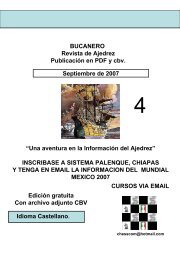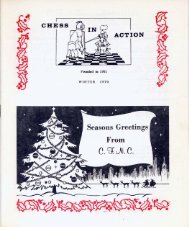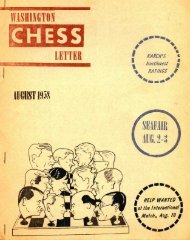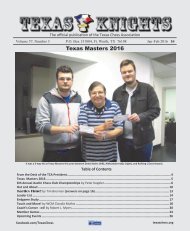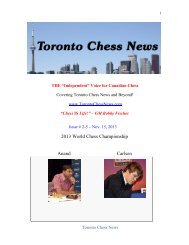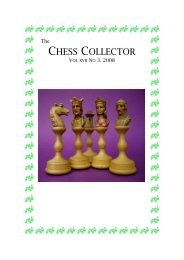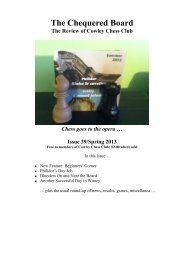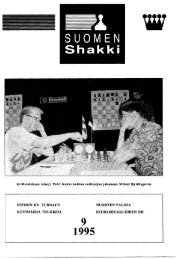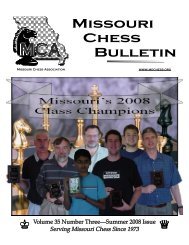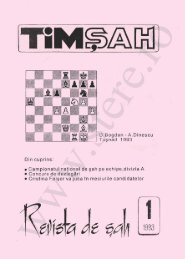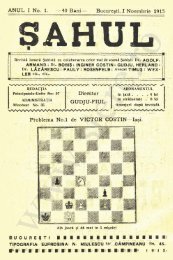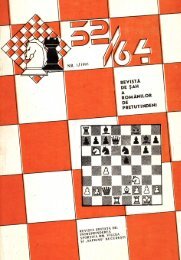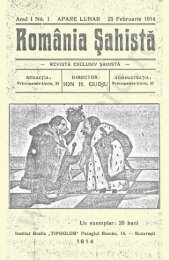Chess Mail
El ajedrez es un juego, considerado un deporte, entre dos personas, cada una de las cuales dispone de 16 piezas móviles que se colocan sobre un tablero dividido en 64 escaques. En su versión de competición está considerado como un deporte.
El ajedrez es un juego, considerado un deporte, entre dos personas, cada una de las cuales dispone de 16 piezas móviles que se colocan sobre un tablero dividido en 64 escaques. En su versión de competición está considerado como un deporte.
You also want an ePaper? Increase the reach of your titles
YUMPU automatically turns print PDFs into web optimized ePapers that Google loves.
46<br />
XIIIIIIIIY<br />
9r+lwqk+-tr0<br />
9zppzpp+pzpp0<br />
9-+n+-sn-+0<br />
9+-vl-zp-sN-0<br />
9-+L+P+-+0<br />
9+-+-+-+-0<br />
9PzPPzP-zPPzP0<br />
9tRNvLQmK-+R0<br />
xiiiiiiiiy<br />
This move, leading to spectacular<br />
complications, was discovered by Czech<br />
master Karel Traxler in the 1890s and was<br />
much analysed by the Wilkes-Barre Club<br />
of the USA in the 1930s. Revived in the<br />
1960s by Yakov Estrin, a lot more has<br />
been discovered about it since.<br />
When studying sharp openings, it is<br />
usually best to look first at “established”<br />
GM sources to see “what the world<br />
knows”. Only then can you judge if a<br />
new idea is actually good.<br />
This approach to study is particularly<br />
valuable for CC as there are often easy<br />
points to be won in sharp openings<br />
against opponents who don’t have good<br />
reference books or up-to-date databases,<br />
and/or who are too ready to believe what<br />
the standard works recommend.<br />
I began with “NCO” (Nunn’s <strong>Chess</strong><br />
Openings, 1998) especially as this was<br />
one of the sections edited by John Nunn<br />
personally. He devotes two lines (and<br />
several notes) to the Traxler.<br />
He said the ¤ capture on f7 is losing<br />
for White while the ¥ capture promises a<br />
slight advantage if followed up by 6 ¥b3!,<br />
but 5 ¥xf7+ ¢e7 6 ¥d5 is unclear.<br />
“ECO” (3 rd edition, 1997) on the other<br />
hand considers 5 ¤xf7 is equal whether<br />
White continues with 6 ¢xf2 or 6 ¢f1.<br />
New evidence may revive the latter.<br />
It is not easy to find new games which<br />
are not on the CD but here are a couple<br />
of recent games which illustrate how<br />
White can lose if he puts a foot wrong.<br />
Eberhard Rosenhahn (GER) -<br />
Jonathan A. Tait (ENG)<br />
Thematic RC/1/93/final corr ICCF, 2000<br />
1 e4 e5 2 ¤f3 ¤c6 3 ¥c4 ¤f6 4 ¤g5<br />
¥c5 5 ¥xf7+<br />
5 ¥xf7+ is the choice of those who<br />
follow orthodox theory or just want to<br />
keep the position under some sort of<br />
control. White settles for just an extra<br />
pawn but it is not easy to prevent Black<br />
from obtaining compensation.<br />
5...¢e7 6 ¥c4!?<br />
Better than its reputation says Heisman.<br />
6 ¥d5 or 6 ¥b3 would be normal;<br />
see the next game.<br />
6...¦f8 7 d3²<br />
Heisman says “A simple move; Black<br />
cannot do anything drastic.” He gives the<br />
following line to illustrate that: 7...¥xf2+?<br />
8 ¢xf2 ¤xe4+ 9 ¢g1 ¤f2 10 £h5 d5 11<br />
¤xh7 ¤xh1 12 ¥g5+ ¦f6 13 £g6+-.<br />
7...d6 8 h3 £e8 9 0–0 £g6 10 ¢h2?<br />
h6 11 ¤f3<br />
XIIIIIIIIY<br />
9r+l+-tr-+0<br />
9zppzp-mk-zp-0<br />
9-+nzp-snqzp0<br />
9+-vl-zp-+-0<br />
9-+L+P+-+0<br />
9+-+P+N+P0<br />
9PzPP+-zPPmK0<br />
9tRNvLQ+R+-0<br />
xiiiiiiiiy<br />
11...¤g4+! 12 hxg4 ¥xg4 13 ¤bd2<br />
£h5+ 14 ¢g1 ¤d4 0–1.<br />
1/2001




